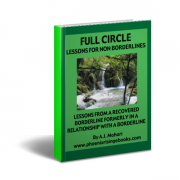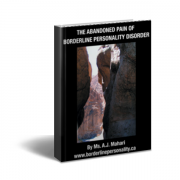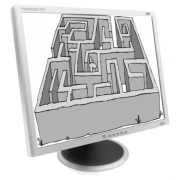Borderline Personality Disorder Defined
What is BPD? What Causes BPD?
Borderline Personality Disorder is defined below by the psychiatric profession in terms of the traits that make up its criteria. Does that mean this is the sum total of what BPD is? I don't think so. Is BPD a "brain disease"? I don't think so. Do all professionals agree that it is a "brain disease"? No. Keep in mind as you read the "definition" below that it is a definition that is pathologizing, narrow-minded, steeped in stigma, and one that offers no hope as to how one can recover from BPD. The DSM-IV definition is only one view. It's psychobabble that is quickly becoming biobabble. How one defines BPD, what one believes about what causes BPD can effect whether or not one has any hope for recovery from BPD. Professionals describe how they define BPD in the DSM, however, they do not offer any such definition when it comes to recovery. I have recovered and in knowing personally that it is possible, I think it is important to not only get your information from the definition below but to also consider other contexts within which mental illness generally, and BPD specifically can be understood. Ways that provide hope. Ways of understanding that do not lend themselves to the pathologizing model of psychiatry.
For more on this please visit my Blog
© A.J. Mahari
"The defining criteria of Borderline Personality
Disorder (BPD) is a pervasive pattern of instability of interpersonal
relationships, self-image, and affects, and marked impulsivity that
begins by early adulthood and is present in a variety of contexts,
"as indicated by five (or more) of the following:

A.J.'s Emotional Mastery Coaching For Borderlines and Non Borderlines
A.J.'s Ebook - Punishment and Revenge in BPD
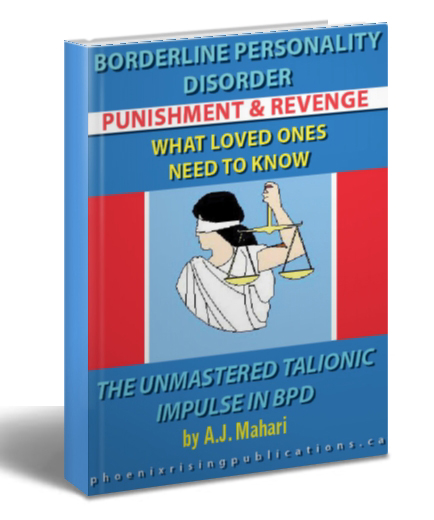 Punishment and
Revenge in Borderline Personality Disorder The Unmastered Talionic Impulse - What Loved Ones Need To Know and what those with BPD will learn from
also if they are in an aware enough place to cope with any triggers that this subject might well bring up for them.
Punishment and
Revenge in Borderline Personality Disorder The Unmastered Talionic Impulse - What Loved Ones Need To Know and what those with BPD will learn from
also if they are in an aware enough place to cope with any triggers that this subject might well bring up for them.
- 1. Frantic efforts to avoid real or imagined abandonment.
- 2. A pattern of unstable and intense interpersonal relationships characterized by alternating between extremes of idealization and devaluation.
- 3. Identity disturbance: markedly and persistently unstable self-image or sense of self; or sense of long-term goals; or career choices, types of friends desired or values preferred.
- 4. Impulsivity in at least two areas that are potentially self-damaging: for example; spending, sex, substance abuse, and binge eating.
- 5. Recurrent suicidal behavior, gestures, or threats, or self-mutilating behavior.
- 6. Affective instability: marked shifts from baseline mood to depression, irritability, or anxiety, usually lasting a few hours and only rarely more than a few days.
- 7. Chronic feelings of emptiness.
- 8. Inappropriate, intense anger or difficulty controlling anger; frequent displays of temper.
- 9. Transient, stress-related paranoid ideation or severe dissociative symptoms.
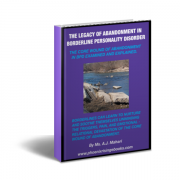 |
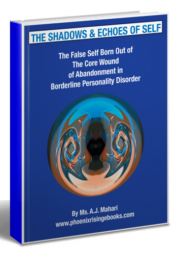 |
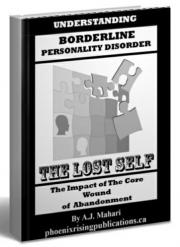 |
 |
 |
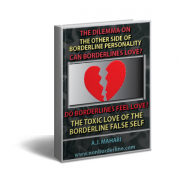 |
A.J. Mahari is currently writing a memoir about her life and experience as a person who had two parents with Borderline Personality Disorder, as a person who was diagnosed herself with BPD at the age of 19 and from her perspective as someone who has recovered from BPD. There is a new section on her BPD Blog called The Diary - My Borderline Years
 Abandonment in BPD Abandonment in BPD |
 Adult Child of BPD - Search For Closure Adult Child of BPD - Search For Closure |
 BPD For Beginners |
 BPD & Splitting - Loved Ones of BPD |
Borderline Personality Disorder is not one "disorder". It is to a great degree a collection of disorders that co-exist and often feed off of each other in ways that make life very difficult for people diagnosed with it.
Borderline Personality Disorder is primarily a relational disorder that I believe stems mainly from the core wound of abandonment that is at the heart of the Legacy of Abandonment in BPD, in so far as the nurture/environmental side of the nature (biology/genetics) vs nurture (unmet developmental needs and core wound of abandonment along with abuse and so forth) debate as to the cause of BPD is concerned.
One thing is for sure, if you have BPD or know and care about someone who does waisting time worrying about what it "should" be called or how it should be better defined is just a life-trap. It won't help anyone with BPD transform their suffering into manageable pain and eventually that pain into the growth necessary to recover from BPD.
For more information and understanding about Borderline Personality Disorder please visit my BPD Inside Out Blog
What every Non Borderline Needs To Know about Borderline Treatment and Recovery
- Post traumatic stress disorder
- Mood disorders
- Panic/anxiety disorders
- Substance abuse (54% of BPs also have this problem)
- Gender identity disorder
- Attention deficit disorder
- Eating disorders
- Multiple personality disorder
- Obsessive-compulsive disorder
- Narcissitic Personality Disorder
- Anti Social Personality Disorder
- Dependent Personality Disorder

It should be noted that many of the traits associated as being BPD traits are commonly found in the general population as well. The line is drawn between the average and the Borderline Personality Disorder person by the number of characteristics listed above that effect them along with the severity or intensity of that affect.
In Borderline Personality Disorder, like DID (MPD), there is (often) a likelihood of a trauma history: "Physical and sexual abuse, neglect, hostile conflict, and early parental loss or separation are more common in the childhood histories of those with Borderline Personality Disorder."
All About Borderline Personality Disorder
For more information and understanding about Borderline Personality Disorder
please visit my BPD Inside Out Blog
and my blog for Family Members of those with BPD People with Borderline Personality Disorder often do not have a very effective or
emotionally mature understanding of boundaries. They often do not know what their own
personal boundaries are or recognize or respect the boundaries of others.
Boundaries and BPD
For the comfort and safety of the client, therapist, and other outsiders, behavioral boundaries often need to be established. These limits may affect a range of issues from details of personal and therapeutic interactions, such as length of therapy sessions; appropriate touching; number, and duration, of phone calls to prevention of assault and suicide. Setting boundaries is particularly important in the treatment of dissociative disorders since lack of boundaries is usually a part of the history of a person who has been abused.
To be able to read the link below you must have Adobe Reader. Click here to download it if you don't have it.
Borderline Personality Disorder
Raising Questions & Finding Answers
(PDF Format)
Borderline personality disorder (BPD) individual's almost always appear to be in a state of crisis. Mood swings are common. These individuals can be argumentative at one moment and depressed at the next and then complain of having no feeling at all, at another time.
There may be short-lived psychotic episodes rather than full-blown episodes or psychotic breaks, and the psychotic symptoms of BPD are almost always circumscribed, fleeting, or in doubt. The behavior of a BPD individuals is highly unpredicatable which makes it difficult for these individual's to achieve up to their potential in life. The repeated self-destructive acts which are "acted out" by Borderlines reflects the very painful nature of their lives. This self-destructive behavior often takes the form of self-mutilation to either elicit help from others, to express anger, or to numb themselves to overwhelming affect.(emotions)
Borderlines often feel both dependent and hostile which in most cases makes for tumultuous interpersonal relationships. They can be very dependent on those to whom they are close and they can express enormous anger at those close, around them in times of frustration. Borderlines have a very low frustration tolerance level as well.
"Facing the Facts of Borderline Personality Disorder - On The Other Side of BPD - For Loved Ones and Family Members of those With BPD"
Audio Program by A.J. Mahari.
As only one who has been there can A.J. Mahari identifies and explains, from the inside out of Borderline Personality Disorder 10 Main Key Central Facts of Borderline Personality Disorder that Loved Ones and Family Members need to understand to free themselves from the painful hooks and emotional traps on the other side of Borderline Personality Disorder.
How Does Borderline Personality Disorder Manifest?
Most Borderlines have a very difficult time being alone. Most frantically will do almost anything to avoid being alone. Borderlines do not have a stable sense of identity and often inspite of many overwhelming affects mention most often, depression.
Functionally, Borderlines are known to put people in either "all good, or all bad" categories. This is known as splitting. The good person is idealized and the bad person is devalued, there is no in between. It is the black and the white, there is no grey area in the world of the unrecovered Borderline.
The depth to which most Borderlines feel their pain is for the most part not understandable to non-borderline individuals. This deep intrapsychic pain is often the pain of a traumatic childhood. Borderlines live in constant fear, terror of having to deal with real or often imagined abandonment. Attachments and bonds are very difficult for borderlines to develop because there are many control and trust issues with which they do not cope well. They have a strong need to protect themselves from anymore pain which sees most borderlines basically being incapable of dealing with their own vulnerablities or the vulnerabilities and emotions of others. Borderline individuals may not seem it to the outside world around them but they are very sensitive people in a great deal of pain. The very unfortuate reality of this personality disorder is that when they need and what they need to the most Borderlines often are compelled by impulse to push away, to sabotoge in order to protect themselves from the agony increasing that is ever present inside.
Borderlines, not unlike anyone often project, to a greater degree, grant it than the average. It is this projection out onto others of all that is essentially reality inside of the borderline themselves that leads them to often be so abusive to those around them. Borderlines struggle very much with image of self and identity and in so doing often have no clear defineable understanding of where they end and the next person begins. This is a boundary issue that has its roots most often in the way in which these individuals were raised. The blurring of boundaries between self and other causes the borderline to act out what is often their own self-hatred and disdain for self onto others. At times it seems as though there is an "average collective reality" in the world and then there is the reality of the Borderline Disordered individual. Disordered dysfunction (inter-personally and or in others areas of life) is the basis of this lifestyle. It is a life that for any Borderline living it, is often entrenched in chaos and marred by virtually inescapable feelings of helplessness and victimization.
© A.J. Mahari
For more information and understanding about Borderline Personality Disorder please visit my BPD Inside Out Blog and my blog for Family Members of those with BPD along with my website for Non Borderlines
- Purchase all 3 of ebooks for NON BORDERLINES packaged together with or without audio.
- Non Borderlines - You can purchase 6 ebooks packaged together with or without audio.
- Those with BPD and/or Non Borderlines can purchase A.J. Mahari's 3 "Core Wound of Abandonment" series ebooks packaged together with or without audio.







